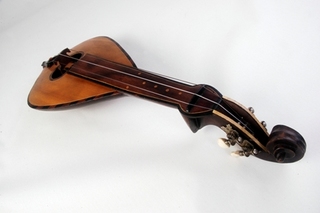Lira de las Islas
Necked bowl lute (321.321-71). It derives from the lura, piriform fiddle played in the Bizantine empire from where it spreads out to Europe during the Middle Ages. In former times lyras were made in different sizes, with one or two sympathetic strings and a bow with bells (yeracocudhuna) so as to emphasize the melody rhythm. Nowadays, the medium size has prevailed and the construction shows influence of that of the violin: pegbox with scroll and lateral pegs, fingerboard and deeper and wider soundbox.
Among its features we can mention a single piece for back, pegbox and neck, as well as a sound post set between the right foot of the bridge and the back.
This popular instrument is played alone or accompanied by a lute or a small drum. The lyra is played in vertical position, resting on the player's knees, the strings being bowed while the vibrating length is shortened by the slanted rubbing of the player's left fingernails.
L. 53.5 x w. 21 x h. 5 cm.
Gift, Ministry of Culture and Sciences of Greece, via the Greek Embassy in Argentina, 1977. IM 622







